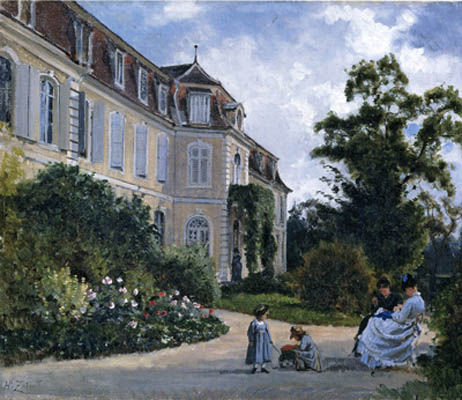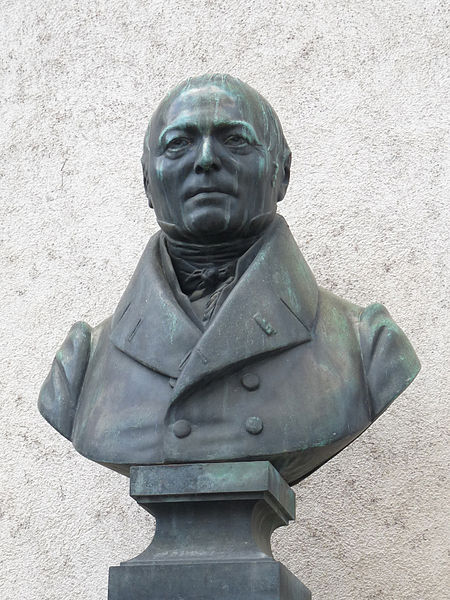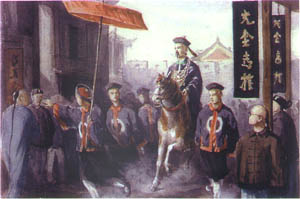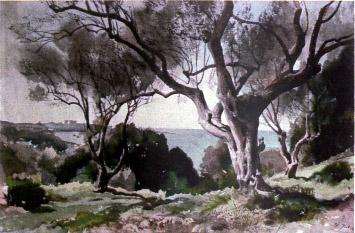| Jean Henri Zuber
was a juior naval officer who came to Korea with the
expedition led by Vice-Admiral Roze in the autumn of
1866. He kept a journal during the expedition which he
used to compose a letter (to his mother?). His grandson, Henri
Ernest Zuber (1901-1967), made a typed copy of portions of that
text (or in HTML
format) which seems to have been preserved in a
'cahier' made or kept by another grandchild, Jeanne
Frey. The son of H.E. Zuber, Professor Roger Zuber,
gave a photocopy of that to a Korean friend from whom
I received it. Professor Zuber gave me permission to
translate and publish it. (English
translation of the letter by Henri Zuber), Henri Zuber later published an account of his impressions of the island of Ganghwa with some critical remarks on the expedition itself in the magazine Le Tour du Monde in 1872 (English version). He also prepared a map of Korea that incorporated the surveys made by the expedition and a Korean map discovered on Ganghwa Island during the expedition. Some of his drawings served as the basis for the engravings accompanying the 1872 text as well as articles about the expedition published in the journal L'Illustration in early 1867. After his return to France he left the navy and became a celebrated artist. Oddly, no original drawing or painting by him of Korea seems to have survived, although works depicting Japan and China exist. He is generally referenced as simply "Henri Zuber." The home page of L'association des amis du peintre Henri Zuber
Biography of Jean Henri Zuber Born 24 June 1844 in Rixheim, Alsace Studied in Strasbourg then Paris, before entering l'École navale de Brest in 1861, where he met the painter of seascapes Étienne Mayer, becoming his pupil from 1862 until 1863. He then joins the French navy, encouraged by his parents. The naval officer Having received the rank of aspirant, he embarks on the Montebello. In 1864, he embarks on the frigate La Thémis which is to escort the Emperor Maximilien from Austria to Mexico. In January 1865 he embarks on the corvette Le Primauguet which is on its way to join the naval division of the China seas, a part of the French naval forces in the Far East based in Saïgon, whose Commander-in-chief at the time is Amiral and Governor of Indochina, Pierre-Paul de La Grandière. During the long journey, Zuber makes notes on and makes drawings of the places visited : Cape Verde Island, Cape of Good Hope, where the ship goes aground, île Maurice, Singapore, reaching Saïgon in November. From there they move to Hong Kong ending up in Yokohama in Japan where le Primauguet joins the French squadron waiting for it. On 8 June 1866, le Primauguet receives orders to set out for Shanghaï, where, under the command of Vice-Admiral Pierre-Gustave Roze a French expedition is being prepared against Korea, which is carried out in two stages between 12 September and 12 November. Given his training, the young ensign Zuber participates in the surveying and mapping of the coastline of Ganghwa Island as well as the Han River, prepares a plan of the anchorage near l'île Boisée (Woody Island), and prepares a map of the Korean peninsula using local documents. After this, he returns to France via Java, Sydney, and New Caledonia. His note books are filled with drawings, sketches and caricatures. All through this long campaign, Zuber produces many watercolors, particularly in China and Japan. The artist On reaching France in 1868, Zuber resigns from the Navy and enters the studio of the Swiss painter Charles Gleyre, determined to make a career as an artist and illustrator. He is admitted to the Salon des artistes français in 1869. In 1870-1871, Zuber is mobilised during the war with Prussia; he sees action in the defense of Paris and the battles at Mont-Valérien. He is demobilized in March 1871 and, Alsace having become German, opts for France and settles in Paris. On 20 July 1871 he marries Madeleine Oppermann, they travel and he paints. They have 4 children. He sets up his studio in the rue de Vaugirard in Paris in 1872. After that date, in addition to making extensive voyages, he makes many excursions in the neighborhood of Paris, and also paints many urban scenes in Paris itself. In 1873 he publishes a narrative based on his participation in the expedition to Korea under Vice-Admiral Roze in 1866 in the illustrated magazine Le Tour du monde produced by Hachette, a celebrated periodical consacred to voyages and discoveries. Zuber is almost the first French writer to produce an account of Korea accompanied by images drawn directly in situ. Instead of descriptions of the military action he was intimately involved in, he gives the priority to the ordinary Koreans he saw, so deferential and childlike, and the magnificent autumn landscapes. He retains his links with Alsace, spends time in the forest of Oltingue where he discovers the splendors of its immense trees. He first works in oils; he spends time at Dinard by the sea ien 1875 and 1877, submits works to the Salons of 1876 and 1878, while also producing some 30 oil studies, a dozen or so watercolors and some drawings. His attention is divided between the rural landscapes of the region and coastal landscapes. He never again visited Britany. He moves south to Menton and Cannes on account of his wife's poor health but she died at Cannes in 1881. Remaining alone in the Midi, he masters the techniques of watercolors. This brings him to the notice of English admirers while he continues to send works to the Salon, where he is increasingly appreciated. In 1883, Henri Zuber marries Hélène Risler, with whom he has another 3 children. He is admitted to the Société des aquarellistes français where he exposes regularly each year. Having become a celebrated artist, he produces two large canvases, Le Troupeau du Vieux Ferrette and Les Premiers Sillons which are acquired respectively by the Museum of Strasbourg and the Louvre. For 2 successive years he exhibits a large collection of watercolors at Goupil & Co in London. In 1886 Henri Zuber is named chevalier de la Légion d'honneur. An incident involving the German occupiers means that he not allowed into Alsace until 1890. Between 1890 and 1894 he makes many journeys: to London, to Mailly-le-Château with the fellow-artist P. Lecomte, to the South of France, to Beauvais. Henri Zuber paints many works in the Île-de-France and Paris, especially in the gardens of the palais du Luxembourg. He spends each summer at Ferrette in Alsace. In 1897 he becomes a member of the jury of the Salon des artistes français. He refuses to apply for admission to the Académie des beaux-arts. He is awarded a gold medal at the Universal Exposition of 1889. In 1900 - 1904 he continues his regular visits to Ferrette. His studio and lodgings in the rue de Vaugirard is demolished to allow the construction of the boulevard Raspail, he moves to 19 rue Vavin; his studio still exists today. In 1906 he is promoted to the grade of officer in the order of the Légion d'honneur. In 1909 Jean-Henri Zuber dies after an operation for a stomach ulcer he had been suffering from since 1883. In 1910 a large retrospective exhibition is organized by his widow and his children under the patronage of the Ministry of Beaux-Arts. Family history The bare bones of a genealogy (mainly based on the information on Geneanet but see also the Notes. The Société Genevoise de Généalogie is also useful but severely limits access to its data. o JACOB ZUBER 1660- & Elisabeth SISSON 1664-1727 o Frederic ZUBER 1702-1758 &1746 Judith MANTZ o Alexandre ZUBER (1747-1781) & Ursula SCHMALZER 1741-1809
o Jean dit Père ZUBER was born in Mulhouse May 1, 1773 - August 8, 1852 he married Elisabeth SPOERLIN (1775-1856) Jean Zuber, said to be of Swiss origin. In 1797 founded the painted wall-paper company Zuber & Cie in Rixheim (Haut-Rhin). (Current Zuber home page) o Jean II dit Fils ZUBER 1799-1853 & Adèle Elise OPPERMANN o Mélanie ZUBER 1834-1906 o Elisabeth ZUBER 1835-1920 o Auguste ERNEST ZUBER 1838-1906 & Noemi RIEDER †1914 o Anna ZUBER 1840-1881 o Jean Henri ZUBER 1844-1909 o Frédéric Zuber (1803 - 1891) married Amélie Frauger; their son Charles Zuber married Cécile Hofer; their son Paul Zuber married Renée Willmann; their son Paul René Zuber (7-2-1898 - 18-2-1992) was a banker but in his free time did much research into the Zuber family's history and genealogy. He married Christiane Monod and they had 7 children, the eldest being Christian Zuber (1930 - 2005) who became a celebrity as a photographer and maker of documentary fims encouraging the protection of nature. During the War, Paul René Zuber took his family to Marocco to avoid the Gestapo. [Jean] Henri Zuber (1844 – 1909) naval officer then artist, Born 24 June 1844 in Rixheim, Alsace, Died 7 April 1909 in Paris On 20 July 1871 Henri Zuber married Madeleine Oppermann, the daughter of Louis Oppermann, a protestant Parisian banker. She died 19 October 1881 in Cannes. 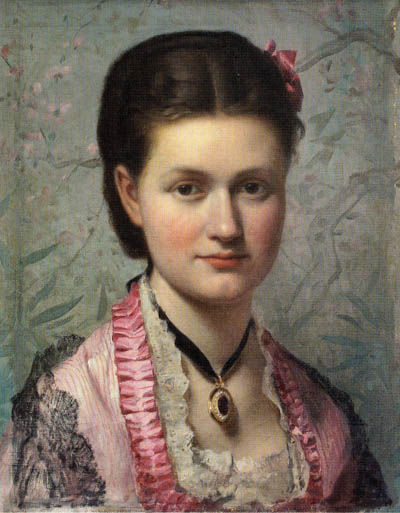 Madeleine Oppermann painted by Henri Zuber The children of (Jean) Henri Zuber with Madeleine Oppermann. . 1. Elise Anna Zuber (13 juillet 1872 - 19 janvier 1932) married Ernest Alfred Zuber (1865-1938) She became an artist, specializing in flowers and landscapes. Ernest Jacques Zuber (b. 1900) Alain Zuber (b. 1903) 2. Henri Adolphe Zuber (1873-1937) who married Catherine Anne Zuber (1874-1952), Henri Adolphe Zuber rose to high positions in the cloth-printing company of Scheurer-Lauth Henri Ernest Zuber (1901-1967) who married Jacqueline Denise Vaucher (1909-2000) Roger Henri Edouard Zuber 1931-2017) (became professor at Paris IV University, a great specialist in French Renaissance Protestant literature) Laurence Sabine Lise (b.1932), Josée Sylvie Anne (b. 1937), Gilles André (b. 1939), Rémy Francois (b. 1945)); Geneviève Zuber (1903-1991) who married Jacques Diemer, they had 3 children. Alfred Claude Zuber (1905-1988, who married Denise Sancery, they had 5 children) Marcel Zuber (1908-1982) who married Antoinette Latham, they had 3 children, Hélène Zuber (b. 1945) married Denis Blech, the author of Henri Zuber - De Pékin à Paris, l'itinéraire d'une passion 1844-1909 (Somogy éditions d'art 2009) 3. Louis Zuber (1875-1958) married Yvonne de Lacroix (1882-1966) in 1903, Louis Zuber took a leading role in the family business at Rixheim. Jeanne Zuber (born March 9, 1911 in Guebwiller, Haut-Rhin, died 1993) married Marcel Frey (their children: Michel, Claude (who married Dominique Roy), Philippe, Georges) 4. Etienne Olivier (1879-1935) married Edith Picot (1888-1956). (They had one daughter, Monique, b. 1918) He was an officer in the army (Jean) Henri Zuber (re)married Hélène Adèle Risler (1857 - 1932) in 1883. Their children: 1. Yves (1884-1960) married Adrienne Picot (1885-1972) they had 2 children. Yves Zuber was a brilliant inventor, the founder of Stylomine company) 2. Paul André Zuber (born October 15, 1891, died pour la France at Soupir (Aisne) April 24, 1917) ancien élève de l'Ecole Polytechnique, lieutenant au 225e d'Artillerie, frappé par un obus de 150, près de la ferme « Cour Soupir », sur la route de Soupir à Ostèl (Chemin-des-Dâmes). Citation : Officier dont là bravoure et le sang-froid font l'admiration 'de tous '; s'est fait remarquer par son mépris absolu du danger, A commandé une batterie avec la plus grande autorité, se portant toujours aux postes d'observation les plus avancés. A été tué le 24 avril 1917. A été cité. 3. Marc Eugène Zuber (born 7 April 1895, élève de l'Ecole Polytechnique, lieutenant au 21e d'Artillerie, observateur à l'Escadrille 219. Volunteered to join the French army in August 1914. Serving in Italy, he was seriously wounded in a plane crash while surveying the battlefront on 28 juin 1917 and died that day) Citation (Légion d'honneur) : Observateur de grande valeur ;. s'est toujours proposé pour les missions les plus difficiles et les plus dangereuses. |
||||
 Rue de Rennes - Boulevard Raspail, Paris |

